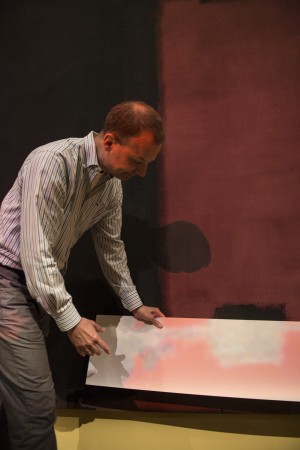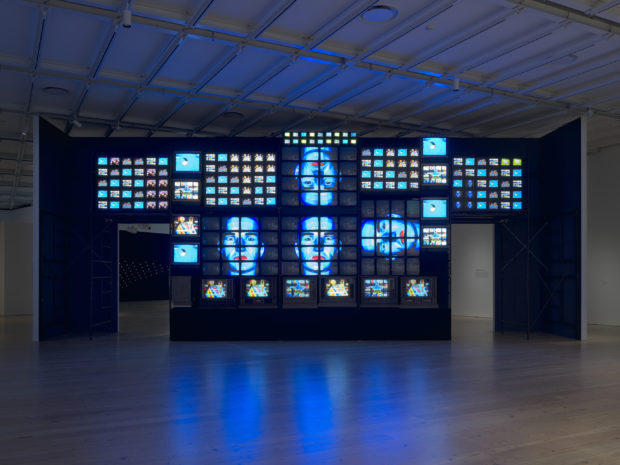On October 22, 2014 at the Institute of Fine Arts, Jens Stenger gave a talk titled “Non-Invasive Color Restoration of Mark Rothko’s Harvard Murals Using Light from a Digital Projector” on behalf of his team (Santiago Cuellar, Rudolph Gschwind, Ankit Mohan, Yasuhiro Mukaigawa, Ramesh Raskar, Katherine Eremin and Narayan Khandekar).

Like many conservation chronicles, this riveting lecture on the recent restoration of Mark Rothko’s storied Harvard Murals had all the elements of a blockbuster drama. The story’s stakes ride not only on the status of the artist—an immeasurable giant of post-war modernism—but also on the works’ conservation history. The five paintings on canvas that comprise the murals were completed in 1962, making these Rothko’s first site-specific grouping of paintings (they were followed by his canvases for Houston’s 1967 Rothko Chapel). The Harvard Murals, as they are known, were made for the boardroom of the university’s new Holyoke Center, designed by Josep Lluís Sert, then Dean of the Graduate School of Design.
The Holyoke Center’s conference room boasted excellent natural light, and over the years the paintings—originally grounded in a deep, winelike crimson of Rothko’s own making, with a different intense hue in each canvas’s foreground—faded abysmally. In the 1980s, a team of conservators determined that the main culprit in the fading was Lithol Red, a highly fugitive pigment that provided the backbone of the murals’ striking crimson. Following this discovery, the paintings were put on public display for the first time in 1988—to general outcry. The paintings that had languished in seclusion during Rothko’s canonization now struck art historians, critics, and the artist’s heirs as withered corpses, shadows of their original glory. After this debacle, the paintings were kept in storage, rarely to be seen again. Until, that is, Stenger’s team proposed a radical new solution.
How, indeed, to restore paintings whose last exhibition functioned as a funeral? How even to summon the audacity to touch these canvases, which, though faded, still preserve the touch of the artist’s hand, that cherished signature of late modernism? The team’s solution transcended this question by projecting carefully-calibrated colored light onto the canvases to alter the viewer’s perception of their surfaces. This “treatment” would focus on the viewer’s experience of the work, rather than the painting as an object, and involve no intervention to the physical surface of the artwork. As the IFA’s Hannelore Roemich, Professor of Conservation Science, reminds us, the phenomenon we call color is an interaction between a light source, a surface, and a viewer. It is not a constant, concrete value, but rather an experience, constantly shifting in response to changes in those three variables. If Stenger and his team couldn’t alter the surface, maybe they could change the lighting enough to make it seem as though they had.

Painstaking detective work was needed to come up with a set of colors that could function as the paintings’ original hues. Comparison with a sixth, well-preserved canvas from the series not installed at Harvard and a color slide of one of the paintings from 1964 (which itself needed restoration) enabled the conservation team to create a “compensation image” for each canvas. This is a painstaking, pixel-by-pixel color correction that is projected onto the surface to make it match the target color. The canvases’ most faded areas, which had lost more Lithol Red, received more red light; the better-preserved areas received less.
The treatment can’t return the paintings to Rothko’s original vision, but it does bring them back to life—and does so while highlighting, rather than obscuring, the artist’s original brushwork. (Many who have seen the restored murals, Stenger said, haven’t even known whether the projector was switched on.) The project also magnificently fulfills conservation’s highest law: that every treatment be reversible. (For more technical details, download the team’s paper here.)
As an art historian interested in how conservation and materiality intertwine with art’s meaning, I was fascinated by the philosophical implications of this exciting project. The use of light, as opposed to more invasive means, is a radical manifestation of the idea that an artwork’s physical apparatus is not constitutive of that work. Rather—even for such traditional media as painting—the physical body of the piece serves as a medium for the viewer’s apprehension of the work.
Stenger pointed out that projected light’s capacity for damage-free restoration has been well known in the conservation community for several decades now, but has rarely been attempted. I think I understand why: we presume that true conservation must be embedded in the physical object itself. We are perhaps unnerved by the practical consequences of the dematerialization of the art object we’ve been talking about since Minimalism and Conceptualism upended the primacy of the artist’s hand in the 1960s. Such lessons have been well digested by art history, yet we remain hesitant in applying them to traditional works of art like paintings. Thus if a side effect of the Harvard project is a decreased tendency to fetishize the art object, along with greater attention paid to the immaterial art experience, then its implications are profound.
Conservation with projected light helps us embrace both the practical possibilities and the theoretical significance of the idea—borrowing from Professor Roemich’s definition of color—that a work of art is actually the interaction between a thing, a viewer, and the circumstances under which the two meet. The restoration of Rothko’s Harvard Murals is another thrilling example of how conservation pushes art history to examine its own aphorisms.
The restored Harvard Murals will be on view at the Harvard Art Museums from November 16, 2014 to July 26, 2015.



Be First to Comment